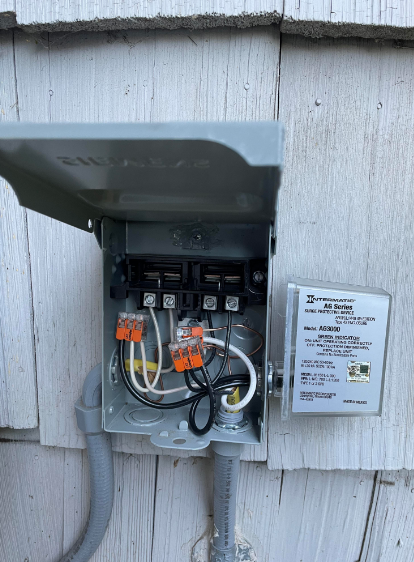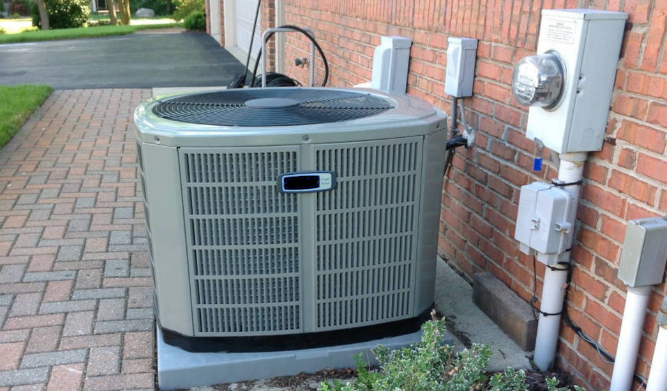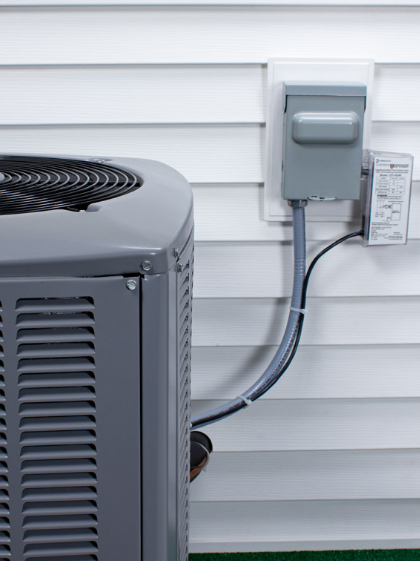An HVAC surge protector costs $50–$400, depending on features. Basic models with 600–1,000 joules start at $50, while high-end ones with 4,000–6,000 joules, real-time monitoring, and warranties cost up to $400. Install costs add $100–$250; always match the joule rating to your HVAC system's value for optimal protection.
Price Range for Basic Models
For basic HVAC surge protectors, you're generally looking at a price range of $50 to $100. These models are designed for straightforward protection and are often sufficient for smaller HVAC systems or areas with less frequent power surges. A basic model rated at about 600 to 1,000 joules-a measure of energy absorption-might cost you approximately $60. This will be adequate for slight surges due to normal fluctuations in the grid. If your HVAC system is valued at over $3,000, though, you may find this level of protection to be a little scant in the long term, especially if you live in areas prone to electrical storms or frequent outages.
The size and capacity of your HVAC system also play a role in the type of surge protector you need. The typical small 2-ton HVAC systems in compact homes might work within a basic protector in this price range, but the larger systems-a 5-ton unit common in houses over 2,000 square feet-may not be adequately covered even with an entry-level protector. These systems usually draw higher amperage, and basic models may not be able to handle such a load, which could leave your expensive equipment vulnerable at times of peak usage.
Another important consideration is the expected lifespan of these surge protectors. A basic model can last anywhere from 3 to 5 years, depending on the frequency and intensity of surges it has to deal with. Let's say you live in an area with about 30 power surges per year. Over three years, that's 90 surges, which might completely deplete the protector's capacity. This means replacing a $70 unit every few years-easy enough to do, but over time it starts to add up. The low joule rating of some models-even a $50 model-would call for a replacement even sooner, therefore becoming an ongoing cost in places with frequent surges.

Mid-Range Surge Protectors
Mid-range surge protectors are generally within the $100 to $200 price range, where a real noticeable step up in features and performance compared to basic models is realized. These will often feature higher joule ratings, typically within the range of 2,000 to 3,000 joules, and are more suitable for homes with larger or more expensive HVAC systems. The theory here is that one good example could be taking a $5,000 - 3-ton unit and adding a $150 surge protector with these types of ratings to protect oneself in the event of a $3,000 plus to repair or replace in such an instance. That added joule capacity now lets these models sustain multiple surges or larger spikes in their lifetime, which is necessary in areas that experience frequent disturbances to supplied power.
More notable in models of the middle range segment is the implementation of technology for thermal protection, the plus for safety by such shutdowns in cases of overheating or extreme power surges. Moreover, some of these series include already LED diagnostic indicators that can be informative for you on whether the protector works actively and if it has received any damages. For instance, one of the most popular mid-range units available for about $120 provides real-time status updates through LED lights, ensuring that the protector will be replaced promptly when it fails, preventing the unprotected operation of the HVAC systems. These features provide peace of mind, especially in areas with more unpredictable power grids.
Another reason mid-range surge protectors are a popular choice for many homeowners is their lifespan. These models are designed to last from 5 to 7 years depending on usage and environmental conditions. For a house receiving an average of about 40 surges a year, this would translate into some 200 to 280 surges that a mid-range protector could absorb before replacement, whereas the basic model may be worn out after 90 to 100 surges. With this extended life span, the mid-range options become even more cost-effective over time, despite having a higher initial price. For a homeowner who may be planning to stay in their residence long-term, this investment becomes even more appealing.

High-End Surge Protectors
High-end HVAC surge protectors cost between $200 and $400. These offer the best protection and come with advanced features that make them well worth the higher price. These devices are designed to handle surges of up to 20,000 volts, making them ideal for areas prone to severe electrical storms or homes with sensitive, high-value HVAC systems. By way of example, a high-quality protector rated at 4,000 to 6,000 joules can absorb numerous large surges over the life of the device. The protection it offers will be robust for systems worth $10,000 or more. If you live in Florida or Texas, places where thunderstorms hit 60 to 80 days per year on average, this level of protection prevents costly repairs or replacements.
One key feature of high-end surge protectors is real-time monitoring and diagnostics. Many models in this category include built-in systems that alert homeowners when the device has reached its capacity or if the HVAC system is operating under risky electrical conditions. For instance, a $350 unit might feature an LCD screen displaying voltage levels, surge activity, and device status, ensuring you’re always aware of your system’s protection level. Advanced features may include surge protection, which will prevent sudden failure, especially during peak seasons when the HVAC systems run at full capacity. High-end units also feature automatic reset functionality, enabling them to resume normal operation after a minor surge without the need for manual intervention, which adds an extra layer of convenience.
High-end protectors usually come with extended warranties, from 10 years up to a lifetime guarantee. These warranties often provide reimbursement for related equipment damage, sometimes up to $25,000 or more, thus offering financial security for homeowners. For instance, a homeowner who has a top-of-the-line surge protector installed on a commercial-grade HVAC system costing $15,000 would be assured that any surge-related damages would be covered. Although this type of warranty adds a premium to the upfront cost, it takes away the potential risk of out-of-pocket expenses for major repairs-well worth it for peace of mind.

Installation Costs
The prices of installing HVAC surge protectors range from $100 to $250, depending on the location, cost of labor, and how intricate the installation process is. Homeowners in areas where the cost of labor is high, such as California or New York, may see quotes at the higher end of this range. For example, a master electrician billing at $100 an hour could take 1.5 to 2 hours to install the protector, making the labor cost $150 to $200. However, in areas where the cost of labor is low-such as in parts of the Midwest-the same installation could cost closer to $100 to $125. So it is important to budget based on local conditions.
The type of HVAC will also affect installation costs. In the case of a simple central air setup, installation is normally quite straightforward since most surge protectors are designed to easily tie into the system's electrical panel. In more complicated configurations-a dual-zone system or 5-ton commercial-grade HVAC unit, for example-installation may require more time and expertise, adding $50 to $100 to the total cost. Depending on the situation, electricians might have to make changes to the current electrical arrangement, like installing a dedicated breaker, which would increase the bill by another $50 to $75.
Another influential factor on the installation cost is whether it's hardwired or plug-and-play. Hardwired versions, offering more permanence and better connectivity, often take an extra 30 to 60 minutes for installation when compared to plug-and-play models. For example, on a more complex HVAC system, the installation of a hardwired surge protector could take upwards of 2.5 hours, especially if adjustments to the electrical panel are needed. This could bring the total cost to around $250 or more, especially in high-demand seasons when electricians charge premium rates.
Joule Rating Impact on Cost
The joule rating is a major determinant in the cost of an HVAC surge protector since it determines how much energy the device can absorb from electrical surges. The prices begin from $50 to about $100 for surge protectors with relatively low ratings of about 600 to 1,000 joules. These units are adequate for little HVAC systems in locations where surge activity is not too high. However, these units may only take out 10 to 20 minor surges before it needs to be replaced. For a homeowner with high frequency or high voltage electrical storms, a protector in this range may not provide good value over the long-term.
Mid-range surge protectors fall in the 2,000 to 3,000 joules range and cost between $100 and $200. This increased joule capacity enables these devices to absorb a lot more energy and take in larger surges. For instance, a 2,500-joule-rated surge protector will handle multiple surges of up to 5,000 volts-a size highly suitable for systems that value upwards of $5,000, including HVAC systems. These units generally tend to be the choice for moderate-risk environments, with power fluctuations a few times a month, such as suburban neighborhoods.
High-end surge protectors with joule ratings of 4,000 to 6,000 joules can cost anywhere from $200 to $400, offering the best protection for premium HVAC systems or commercial setups. As an example, a protector rated at 5,000 joules might handle a 20,000-volt surge, which could occur during a severe lightning strike. These are very useful in high-risk states like Florida, which experience an average of 1.2 million lightning strikes annually, and also face a lot of power surges. The price is higher because they will protect HVAC systems worth 10,000 to 15,000 dollars, plus additional features such as diagnostic indicators and extended warranties.
Size of HVAC Unit
As can be expected, size in regard to your HVAC directly determines type and price for your surge protector. Smaller ones, such as systems like 2 tons designed to cater to homes smaller than 1,200 square feet, usually combine pretty well with surge protectors ranging in the realm of $50 to $100. Because these systems are smaller, they don't require as much amperage and pull less electrical load, so a surge protector rated for approximately 600 to 1,000 joules will be acceptable. While the upfront costs are lower, these units may not last long under frequent power fluctuations in many regions, thus tacking more replacement costs onto their lifetime.
For mid-sized HVAC systems-like 3- to 4-ton units for 1,500 to 2,500 square feet-the surge protectors usually cost in the range of $100 to $200. These units generally need higher amperage and work under heavier loads, mainly when the weather is at its hottest or coldest. You will be just fine with a 2,000-3,000 joule-rated surge protector in this size category. They have increased resilience and could take medium-intensity surges. A typical system, costing within the ranges of $5,000 to $7,000, would probably call for a mid-range protector as assurance for one's safety, especially where suburbs come in and have frequent fluctuation.
Larger systems, like those 5-ton HVACs meant for houses above 3,000 square feet, require high-capacity surge protectors that run a little higher-in the area of $200 to $400. Not only will these units require more power, but they will be more sensitive to surges because of the more involved components. Generally, the 4,000 to 6,000-joule-rated surge protector is recommended, which, in turn, handles most of the voltage spikes easily without failing. For instance, a commercial-grade HVAC system worth $10,000 or more might experience significant damage from a single surge if improperly protected. Spending $300 on a high-end protector with industrial-grade components is a cost-effective way to mitigate such risks.
Additional Features
Additional features in HVAC surge protectors can significantly impact their cost, with prices ranging from $150 to $400, depending on the complexity and functionality of these enhancements. For instance, surge protectors equipped with real-time diagnostic indicators, such as LED lights or LCD screens, often cost $50 to $100 more than basic models. These features provide clear, instant feedback on the device's status, such as whether it's actively protecting your HVAC system or needs replacement. For a unit valued at $5,000 to $10,000, this transparency can prevent unexpected failures, saving both money and stress in the long term.
Another sought-after feature is automatic reset capability, which ensures the surge protector resumes normal operation after handling a minor surge. This is particularly useful in areas with frequent power fluctuations, as it eliminates the need for manual resets. Protectors with automatic reset functionality are typically priced around $200 to $300, about 20–30% higher than comparable models without this feature. For example, in a region experiencing 30–40 surges annually, this feature ensures consistent protection without the hassle of constant monitoring or resetting.
High-end surge protectors may also include Wi-Fi connectivity or smart home integration, allowing homeowners to monitor surge activity and protection status through mobile apps or smart home platforms. These advanced models can cost between $300 and $400 and are ideal for tech-savvy individuals or those with smart home systems. For example, a $350 model might allow users to receive alerts about power surges directly to their smartphone, providing peace of mind for homeowners frequently away from their property. These features are particularly valuable for protecting high-cost HVAC systems, often priced at $7,000 to $15,000, in locations with unpredictable weather patterns.
